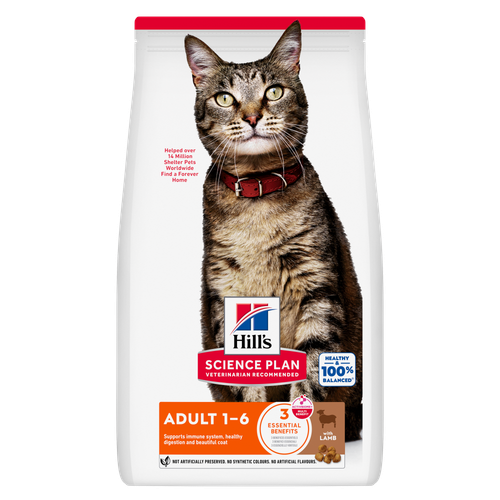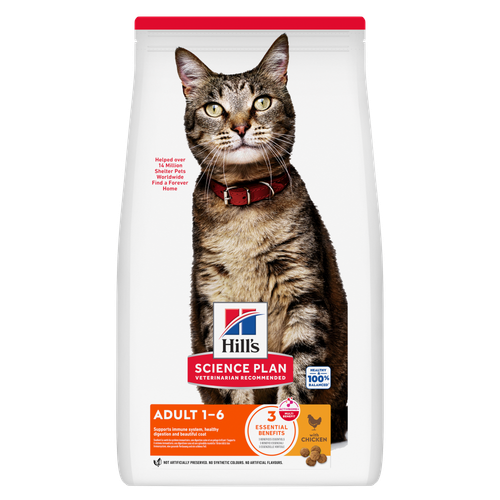
-
Featured products
 Small & Mini Puppy Dog Food
Small & Mini Puppy Dog FoodHill's Science Plan Puppy Small & Mini Breed Dog Food with Chicken is a complete pet food, specially formulated with ActivBiome+ Multi-Benefit Technology.
100% balanced nutrition to support optimal growth & the immune system.Shop Now Perfect Weight Adult Dog Food with Chicken & Vegetables
Perfect Weight Adult Dog Food with Chicken & VegetablesHill's Science Plan Perfect Weight Adult Dog Food with Chicken & Vegetables ia a complete premium dog food for dogs prone to weight gain or who are slightly overweight. This savoury tinned loaf is enriched with ingredients that support healthy weight maintenance & long-lasting weight support.
Shop Now Small & Mini Adult Dog Food
Small & Mini Adult Dog FoodHill's Science Plan Small & Mini Breed Adult Dog Food with Lamb & Rice is a complete pet food, specially formulated with ActivBiome+ Multi-Benefit Technology.
Tailored nutrition for the unique needs of small dogs during the prime of their life.Shop NowFeatured products Adult Cat Food
Adult Cat FoodHill's Science Plan Adult Cat Food with Lamb & Rice is a complete pet food, specially formulated with ActivBiome+ Multi-Benefit Technology.
This food is specially formulated to fuel the energy needs of cats during the prime of their life.Shop Now Feline Adult Wet Food
Feline Adult Wet FoodTender chunks in gravy for cats, with high-quality protein to maintain lean muscle. With vitamin E and omega-3s & -6s for healthy skin and balanced minerals to support healthy vital organs.
Shop Now Adult Cat Food
Adult Cat FoodHill's Science Plan Adult Cat Food with Chicken is a complete pet food, specially formulated with ActivBiome+ Multi-Benefit Technology.
This food is specially formulated to fuel the energy needs of cats during the prime of their life.Shop Now -
Dog
- Dog Tips & Articles
-
Health Category
- Weight
- Food & Environmental Sensitivities
- Urinary
- Digestive
- Joint
- Kidney
-
Life Stage
- Puppy Nutrition
- Adult Nutrition
- Senior Nutrition
Cat- Cat Tips & Articles
-
Health Category
- Weight
- Skin & Food Sensitivities
- Urinary
- Digestive
- Kidney
-
Life Stage
- Kitten Nutrition
- Adult Nutrition
Featured articles The Right Diet For Your Pet
The Right Diet For Your PetIn people, the right diet is very important. If you are eating the wrong way for your metabolism, activity level, age and lifestyle you could end up with health issues.
Read More Show some love with wet foods: a great choice for pets with health issues
Show some love with wet foods: a great choice for pets with health issuesShow some love with wet foods: a great choice for pets with health issues.
Read More Proteins
ProteinsTo make a protein, amino acids are linked together in a long chain. The chain is then bundled into to a three-dimensional structure, like a tangled ball of yarn.
Read More -


A lot happens during a kitten's first year. It's hard to believe that a tiny, meowing kitten that fits in the palm of your hand can grow into a full-fledged adult cat in the length of only twelve months. A typical kitten growth chart shows that most of the changes — and the most amazing ones — happen during the first eight weeks. Check out this kitten timeline to learn when to expect certain milestones on your kitten's journey to becoming a cat.
1 – 3 Weeks: Kittens Open Their Eyes and Ears
 Kittens come into the world with their eyes and ears closed and spend the first week or so of their lives blind and deaf. Their eyes and ears start to open during the second week, says Cats Protection, but their vision and hearing aren’t very good yet. It’s a good idea to keep them away from bright lights and loud noises at this point. The blue eyes that kittens are born with may start to change colour from their third week, which is also when their ears start to perk up and point upwards, introducing them to a whole new world filled with sound.
Kittens come into the world with their eyes and ears closed and spend the first week or so of their lives blind and deaf. Their eyes and ears start to open during the second week, says Cats Protection, but their vision and hearing aren’t very good yet. It’s a good idea to keep them away from bright lights and loud noises at this point. The blue eyes that kittens are born with may start to change colour from their third week, which is also when their ears start to perk up and point upwards, introducing them to a whole new world filled with sound.
Kittens will start to make little “meowing” noises a few days after birth to let their mother know they're hungry or distressed, says Cats Protection, with purring typically beginning a few weeks later. Kittens tend to become more vocal as they start walking, playing and exploring their surroundings.
3 – 7 Weeks: Walking, Weaning and Using the Litter Box
Around three weeks of age is usually when kittens start to take their first shaky steps. They start out wobbly and unsure but, as balance begins to improve during the fourth week, they become more confident and eager to explore their surroundings. By the fifth or six week, when kittens are confident enough in their newfound mobility, you’ll see your kitten’s energetic, playful and curious nature start to emerge! Under your close supervision, you can start letting them explore their surroundings and experience new sights, sounds and smells. This is a good time to start kitten-proofing your home if you haven't already done so.
During the fourth and fifth week of the kitten timeline, your kitten’s balance should be improving. This is a good time to introduce them to the litter box, says Cats Protection. Kittens typically learn what to do from watching mum, so all you really need to do is show them the box. Just keep in mind that they're still learning and accidents will happen.
Kittens can be introduced to solid food from their third week, but weaning is a gradual process that can take a few weeks to complete. The Pet Food Manufacturers’ Association (PFMA) recommends feeding the nursing mother and her kittens the same complete kitten food during the early stage of weaning to help with the transition. While they may be eating the same food, the kittens should be offered a moist form or soaked dry foods when beginning the weaning process.
By six to eight weeks, your kittens will have finished the transition to solid food and should be exclusively fed high-quality kitten food. For guidance on how much to feed, the PFMA recommends following the manufacturer’s guidelines printed on the pack and weighing the kitten’s food with accurate kitchen scales to ensure they get the right amount of energy and nutrients. Most kittens will want to be fed “little and often”, so you may want to divide their daily food intake into smaller portions throughout the day. However, each kitten is unique, so monitor your kitten’s development and body condition, adjust their feeding patterns accordingly, and speak to your vet if you have any concerns.


Tasty Tips
8 – 12 Weeks: Socialising and First Vaccines
Did you know kittens will have two sets of teeth as they age, just like humans? Feline baby teeth start coming in during the second week, and your kitten should have all of their baby teeth by about eight weeks of age. By four months, their adult teeth will start to appear, and they should have all of their adult teeth by six months.
Your kitten should be taken to their first veterinary visit during this time period. They will need their first vaccinations at around eight weeks, followed by boosters at around 12 weeks. The RSPCA says that kittens are commonly vaccinated against feline herpes virus, feline calicivirus, feline infectious enteritis, and feline leukaemia virus. Your veterinarian can advise you on other conditions your kitten may need to be vaccinated against.
This is the ideal window to start socialising your kitten. Grooming, cuddling and playing with your kitten will not only support their development and build your bond, but it will get your kitten used to being picked up and handled. The RSPCA says it’s also the right time to start introducing your kitten to other people and children, as well as other healthy, fully vaccinated cats and dogs. This will not only prepare them to go to their eventual forever homes but will also help them grow into emotionally healthy, well-adjusted adult cats.

3 – 6 Months: Ready for Adoption and Neutering
Kittens shouldn't be separated from their mother and littermates until they have been fully weaned and socialised. Kittens continue learning normal cat behaviour from their mother until well into their tenth week, so in order to give each kitten the best chance of becoming a well-adjusted cat, it's best to wait until at least ten weeks before allowing them to go to a new home. You can also wait twelve weeks to allow time for the next important round of vaccinations in the kitten timeline.
Most kittens are ready to be spayed or neutered from around four months onwards, although a veterinarian may perform the procedure earlier if they judge that the kitten can safely undergo general anaesthesia.
One Year: No Longer a Kitten
By the time they reach their first birthday, a kitten is no longer considered a kitten but is now a full-grown cat. Although they may still engage in kittenish behaviour and may still have some additional growing to do, your newly adult cat is ready to transition to a high-quality adult cat food formula. Follow the recommended feeding guidelines on the new cat food to determine how much and how often they should be fed.
Although a cat is considered an adult by one year of age, developmentally speaking, kitten adolescence typically lasts until a cat reaches eighteen months or so. During this time, a cat might still exhibit the energetic playfulness of a kitten, as well as typical "teenager" behaviour, which may include testing boundaries and acts of rebellion like scratching the furniture or marking territory. But not to worry. Usually, cats start to mature and settle down after the eighteen-month mark, and by their second birthday your cat will have fully grown into their adult personality.
Watching a kitten grow from a tiny newborn to a full-grown cat is a wondrous thing. Knowing what to expect as your kitten grows will empower you to help them grow into a healthy and happy companion.


Jean Marie Bauhaus is a pet parent, pet blogger, and novelist from Tulsa, Oklahoma, where she usually writes under the supervision of a lapful of fur babies.
Related products

Hill's Science Plan Adult Cat Food with Lamb & Rice is a complete pet food, specially formulated with ActivBiome+ Multi-Benefit Technology.
This food is specially formulated to fuel the energy needs of cats during the prime of their life.

Hill's Science Plan Adult Cat Food with Chicken is a complete pet food, specially formulated with ActivBiome+ Multi-Benefit Technology.
This food is specially formulated to fuel the energy needs of cats during the prime of their life.

Hill's Science Plan Sterilised Kitten Cat Food with Salmon is specially formulated with ActivBiome+ Multi-Benefit Technology. This food is carefully formulated for the developmental needs of kittens, so they get the best start in life & grow to their full potential.

Tender chunks in gravy for cats, with high-quality protein to maintain lean muscle. With vitamin E and omega-3s & -6s for healthy skin and balanced minerals to support healthy vital organs.
Related articles

From essential vitamins & minerals to different types of meat, learn what to look for when choosing the best cat food for your feline.

Cats are very clean creatures and your kitten will spend approximately five hours a day grooming herself. In doing so, they'll pick up any loose hairs from their coat.

Many human foods are dangerous to cats. Read about 5 of the worst toxic food offenders that can kill your cat - and how much it takes to hurt them.

Selecting the right food for your kitten is a key to quality nutrition and a long, healthy life. Learn more about how to select the right kitten food.

Put your cat on a diet without them knowing
Our low calorie formula helps you control your cat's weight. It's packed with high-quality protein for building lean muscles, and made with purposeful ingredients for a flavorful, nutritious meal. Clinically proven antioxidants, Vitamin C+E, help promote a healthy immune system.
Put your cat on a diet without them knowing
Our low calorie formula helps you control your cat's weight. It's packed with high-quality protein for building lean muscles, and made with purposeful ingredients for a flavorful, nutritious meal. Clinically proven antioxidants, Vitamin C+E, help promote a healthy immune system.

